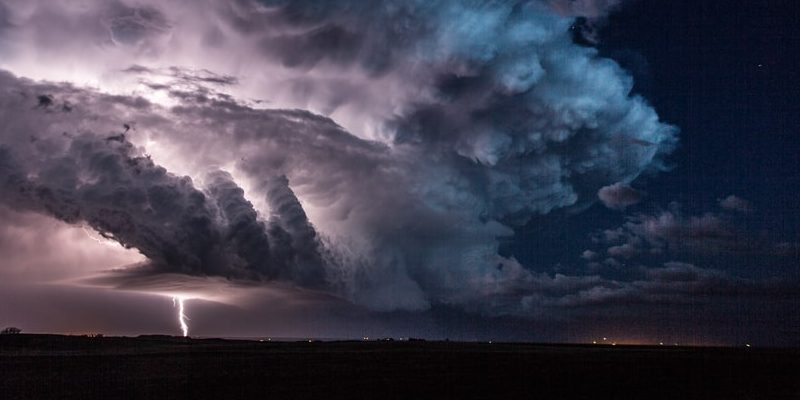We explain what rain is, its origin and how this phenomenon can be measured. Also, what are its characteristics, risks and benefits.
What is rain?
Rain is a very common atmospheric and hydro meteorological phenomenon on our planet , which consists of the fall of liquid water particles in the form of scattered drops, the product of the condensation and cooling of water vapor high in the atmosphere .
It is sometimes referred to as precipitation , but this is really a broader category. Rain occurs daily in different regions of the planet , in some more frequently than in others, both on the sea and on the land.
The generation of rain depends on three specific factors : temperature , atmospheric pressure and atmospheric humidity.
What we call rain is nothing more than an instant in the hydrological cycle or water cycle . In it, the water deposits in oceans , lakes , rivers and on the earth's surface evaporate by the action of the Sun , they go to the atmosphere where they cool and condense into a cloud.
As soon as this condensed water gives way to the weight of matter and the liquid is released from above, rain is produced, which then repeats the circuit.
Origin of the rain

Rain is as old as the massive presence of water on the planet.
In other words, it is estimated that it originated with our planet , 3.8 billion years ago.
There are two theories about it:
- Volcanic formation. According to this theory, water originated in the center of the Earth, as a consequence of intense reactions between oxygen and hydrogen , being then expelled in the form of vapor into the atmosphere by the intense volcanic activity that the planet presented in its beginnings.
- Extraterrestrial causes. This theory proposes that the water reached the Earth in numerous meteorites or icy comets, rich in ice sheets from an unknown corner of space. Thus, upon impacting our then volcanic planet, the high temperatures melted it and generated the oceans.
How is rain formed?
Rain forms in different types of clouds , such as cumulonimbus and nimbostratus, which receive all the moisture from the atmosphere.
When they rise to colder regions, their vapor condenses and therefore falls , due to the increase in weight.
This training can take place in three ways:
- Convection showers. The hot air in contact with the earth's surface is heated by the action of the Sun and rises, cooling down and producing rain.
- Orographic rains. They occur when a mass of humid air collides with a mountainous relief , ascending its slope and discharging its humidity, until it descends dry on the other side of the elevation.
- Frontal rains. They are generated by the collision of two masses of humid air with different temperatures (one warm and the other cold). These are usually of the stormy or hurricane type.
How is rain measured?

Rain is measured in millimeters of fallen water , or also in liters fallen per unit area (m 2 ).
The device used to measure rain is the rain gauge , which calculates the amount of water that the rain would accumulate on a flat, horizontal, impermeable surface during the duration of the precipitation.
There are various types of rain gauge, widely used by climatologists or geographers in their analysis of the various regions of the planet, or in the study of climatic phenomena.
What does rainwater contain?
The raindrops have a diameter of approximately 0.5 mm .
They are spherical (no, they do not have the classic "teardrop" shape) or hemispherical particles of water, in which, ideally, there is no significant presence of other chemical elements that could be in the atmosphere.
If the opposite occurs, we can be in the presence of dirty rains (that drag ash or dust) , acidic (that contain molecules of some oxide reacting with the water to make its pH more acidic) or even radioactive (if there are unstable chemical elements in it. ).
Rain distribution

Every year about 505,000 km 3 of water falls in the form of rain in the world. Of them, 398,000 on the oceans and 107,000 on the land surface.
On a planetary level, the region with the highest annual rainfall is the Intertropical Convergence Zone , close to the Equator , where the most intense rains would take place.
As you move over the temperate zones , the rainfall reaches more stable averages , depending on the seasons or taking into account specific weather conditions.
In the polar or semi- polar region , rains are practically non-existent, given the low temperatures of the dry air at the pole .
Types of rain

According to its intensity, the rain can be classified as follows:
- Drizzle or garúa. A very weak rain, of fine droplets often sprayed in the air, the accumulation of which is almost negligible.
- Squall or downpour. Rains of medium to strong intensity, usually of short duration and accompanied by wind.
- Downpour. Torrential rain, of medium duration, that accumulates large amounts of water on the surface.
- Thunderstorm . Heavy rains, accompanied by intense winds and electrical activity in the atmosphere, due to the static generated by charged clouds. It can be accompanied by hail, snow, lightning and commonly thunder that announce them even before they occur.
- Hurricane or waterspout. The maximum degree of a storm, in which two air masses of different temperatures (hot and cold) meet and rotate around each other, producing a zone of low pressure that reproduces the cycle. Its enormous precipitation margins are accompanied by very intense winds.
What are the consequences of the rain?
Rain has important and far-reaching consequences on the planet, among which are:
- The irrigation of water in the different regions of the earth's surface, allowing the maintenance of plant life and feeding rivers, lakes and lagoons.
- Balance of environmental temperatures throughout the world, as well as salinity and temperature levels in oceanic water.
- Washing and runoff from the earth's surface, being able to displace solid matter .
- In cases of excess rain, it produces floods when the soil no longer manages to absorb more liquid and the water begins to pool.
- In cases of torrential rains, they often cause damage to urban infrastructure, floods, river flooding and loss of life.
Why is rain important?

Rain can be a beneficial as well as a destructive factor , but it is undoubtedly fundamental in preserving the planet's climate balance.
Thanks to the rain, the water circulates through various places , keeping them humid enough to house plant life, or giving rise to accumulations that will later be rivers, lakes, etc. Without it, life would be unviable.
On the other hand, the rain allows the cooling and humidification of the air in different regions of the globe, keeping the temperature relatively stable and combating global warming .
For the human being it is a source of free, regular and relatively clean water , usable for various purposes, especially agricultural ones.
Finally, it is also a phenomenon that cleans the air , bringing freshness and clarity to the atmosphere, and that maintains the level of salinity of the oceans stable.
Rainy season
The rainy season, rainy season or monsoon season is the time of year when the heaviest rainfall in a region usually occurs .
They generally last one or several months , and are distributed throughout the tropics and subtropics, where they produce recurrent rain belts.
Other forms of precipitation

There are other forms of precipitation that do not involve the fall of liquid water, such as:
- The snowfall. If the pressure and temperature conditions are correct, the water falling from the atmosphere will be in a semi-solid state known as snow.
- The hailstorms. In case the atmospheric pressure is particularly low, the water in the atmosphere can freeze instead of condensing, falling to the ground in the form of small pieces of solid ice known as hail.
- Sleet. Known as granulated ice, sleet is rain that freezes before it hits the ground.
Luke is passionate about fostering student involvement and connection. He studied psychology for his major and likes learning about the past. Luke aims to specialize in artificial intelligence and cybersecurity. .
Leave a reply
Your email address will not be published. Required fields are marked *Recent post

Sport: What Is It, Types, Risks, Features, Characteristics and Examples

Dogs: Emergence, Features, Characteristics, Feeding and Breeds

Story: Definition, Elements, Structure, Features and Characteristics

